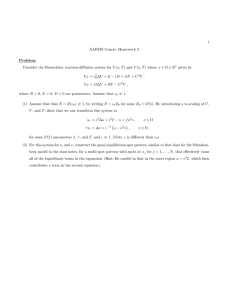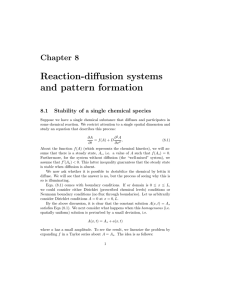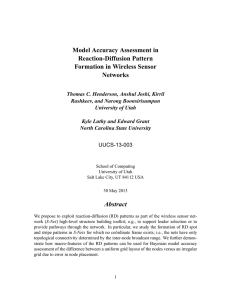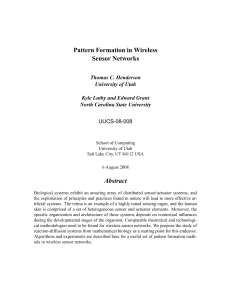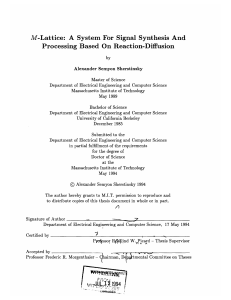Reaction-diffusion equations and pattern Chapter 6 6.1
advertisement
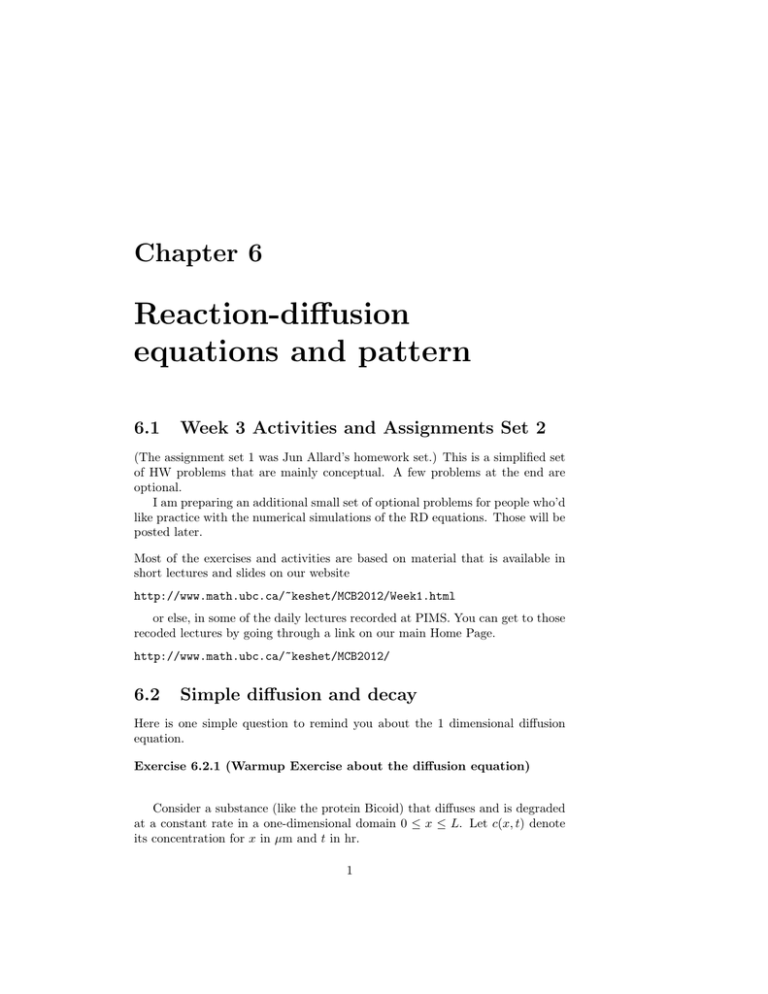
Chapter 6 Reaction-diffusion equations and pattern 6.1 Week 3 Activities and Assignments Set 2 (The assignment set 1 was Jun Allard’s homework set.) This is a simplified set of HW problems that are mainly conceptual. A few problems at the end are optional. I am preparing an additional small set of optional problems for people who’d like practice with the numerical simulations of the RD equations. Those will be posted later. Most of the exercises and activities are based on material that is available in short lectures and slides on our website http://www.math.ubc.ca/~keshet/MCB2012/Week1.html or else, in some of the daily lectures recorded at PIMS. You can get to those recoded lectures by going through a link on our main Home Page. http://www.math.ubc.ca/~keshet/MCB2012/ 6.2 Simple diffusion and decay Here is one simple question to remind you about the 1 dimensional diffusion equation. Exercise 6.2.1 (Warmup Exercise about the diffusion equation) Consider a substance (like the protein Bicoid) that diffuses and is degraded at a constant rate in a one-dimensional domain 0 ≤ x ≤ L. Let c(x, t) denote its concentration for x in µm and t in hr. 1 2 CHAPTER 6. REACTION-DIFFUSION EQUATIONS AND PATTERN (a) Explain the equation ∂c ∂2c = D 2 − γc ∂t ∂x (6.1) and determine what are the units of γ, D (both assumed to be positive constants). (b) Can you find a parameter grouping with units of distance? In what sense can we call that ratio a “diffusion distance”? (c) Find the steady state concentration profile c(x) assuming that at x = 0 the concentration is kept fixed at the value c0 . [Remark: while we would specify a sealed end at x = L, here we will just assume that the domain is very large compared to the diffusion distance. This will mean that the “no-flux” condition will be (approximately) satisfied at x = L. Why is that true?] (d) Now we will consider another problem in which a protein satisfies equation (6.1) but where the two ends of the domain are sealed (no flus, i.e. ∂c/∂x = 0 at both x = 0, L. Show that c(x, t) = Aeσt cos(qx) is an appropriate solution to (6.1) for certain values of the wavenumber q (what are the allowed values of q)? Can this type of solution ever grow in time? Explain your answer. 6.3 Reaction-diffusion systems and pattern formation Now we will look more closely at a pair of reaction-diffusion equations ∂A ∂2A = f (A, B) + DA 2 , ∂t ∂x ∂B ∂2B = g(A, B) + DB 2 , ∂t ∂x (6.2a) (6.2b) where f, g are terms for the reaction kinetics. Such PDE’s require two boundary conditions each to be well-posed, by virtue of their second partial derivatives and parabolic character. To represent no leakage of material out of the domain the appropriate conditions are the Neumann boundary conditions, ∂A ∂B = 0, = 0, (6.3) ∂x x=0,L ∂x x=0,L The following two problems are simple conceptual questions for which little calculation is required. See lecture slides to remind yourself what results can be used to answer these. 6.3. REACTION-DIFFUSION SYSTEMS AND PATTERN FORMATION 3 Exercise 6.3.2 (Schemes that can produce patterns) Look at the four chemical feedback schemes shown for pairs of interacting proteins in Figure 6.1. Based on the analysis we did, which of these might be expected to lead to Turing pattern formation (given appropriate parameter values). For those that do, what can you say about the respective rates of diffusion of the two substances (which should be larger)? Figure 6.1: Figure for Problem 2. Exercise 6.3.3 (Turing pattern formation, continued) Here we consider three different examples of a pair of reaction-diffusion equations. Each system consists of two interacting proteins, diffusing in a single dimension in a domain of size 20µm (with sealed ends) with rates of diffusion D1 = 0.1, D2 = 1µm2 /s. Someone has saved you a lot of work by computing the Jacobian matrix for each of the well-mixed systems. These are shown below: (a) 2 −2 3 −1 , (b) 2 2 −1 −3 , (c) 0.2 2 −1 −3 All values carry units of 1/s. (a) For each of these examples determine whether or not Turing instability (and pattern formation) can occur. 4 CHAPTER 6. REACTION-DIFFUSION EQUATIONS AND PATTERN (b) If Turing instability is NOT expected to occur, what adjustment in the value of D1 would just barely put this system into the regime of Turing instability? (c) In yet another system, you are only told that the Jacobian matrix has entries a11 = 0.52, a22 = −2. It is determined that this system just barely has a Turing instability. What type of pattern would you expect to see growing? (Hint: think “wavenumber”, and what it represents). Assume that the domain size, boundaries and rates of diffusion are as specified in the statement of the problem. 6.4 OPTIONAL: stability analysis of patternforming system An example discussed in the lectures is the Schnakenberg system, for which the chemical reaction terms are: f (A, B) = k1 − k2 A + k3 A2 B, 2 g(A, B) = k4 − k3 A B. (6.4a) (6.4b) here it is assumed that DA DB . It can be shown (Exercise 6.4.4) that, after appropriate rescaling, the dimensionless form of these equations is ∂2u ∂u = ω(a − u + u2 v) + D 2 , ∂t ∂x ∂v ∂2v 2 = ω(b − u v) + , ∂t ∂x2 (6.5a) (6.5b) Assume that A diffuses slowly compared to B, which means that D 1. Exercise 6.4.4 (OPTIONAL: Nondimensionalization) Show that the system (6.2) with the Schankenberg functions given by (6.4) can be rescaled to the system (6.5). What scaling has been used, and how do the new parameters relate to the original set? The Schnakenberg system is particularly convenient since it is easy to solve for its unique steady state, and thus determine all stability conditions analytically. We find that spatially homogeneous steady state solutions satisfying 0 = f (u, v) ≡ ω(a − u + u2 v), 2 0 = g(u, v) ≡ ω(b − u v), (6.6a) (6.6b) 6.4. OPTIONAL: STABILITY ANALYSIS OF PATTERN-FORMING SYSTEM5 are u = a + b, v= b (a + b)2 (6.7) The stability of the homogeneous steady state (6.7) can be determined from its Jacobian matrix, fu fv −1 + 2uv u2 J= =ω (6.8) gu gv −2uv −u2 and the stability to spatial patterns can be determined from the augmented Jacobian −1 + 2uv − q 2 u2 J =ω (6.9) −2uv −u2 − dq 2 Exercise 6.4.5 (OPTIONAL Schnakenberg model analysis) (This is for people who would like to go through the step-by step analysis.) First, verify the above statements. Then, use them to determine the following: (a) The wavenumber qmin that will first destabilize the spatially homogeneous steady state. (This will depend on parameters in the equations.) (b) Conditions for Turing pattern formation to occur in this system.
